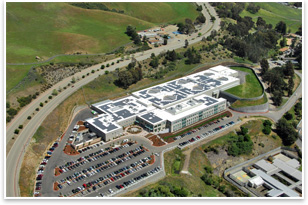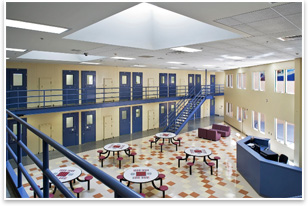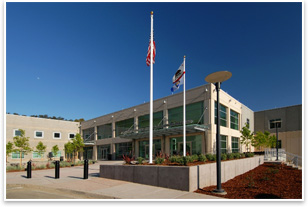San Leandro Juvenile Justice Facility Garners Gold
Diverse approach yields benefits for juvenile offenders and the environment
by Heather Livingston
Contributing Editor
 Summary: Designed by the San Francisco office of HOK, the Alameda County Juvenile Justice Center is the first and only juvenile justice facility in the U.S. to attain LEED® Gold certification. The justice center, which has exceeded California’s Title 24 energy efficiency standards by over 40 percent, relied on a varied strategy for achieving sustainability that included an 880 kW PV array and bio-diesel excavation and site clearing. Summary: Designed by the San Francisco office of HOK, the Alameda County Juvenile Justice Center is the first and only juvenile justice facility in the U.S. to attain LEED® Gold certification. The justice center, which has exceeded California’s Title 24 energy efficiency standards by over 40 percent, relied on a varied strategy for achieving sustainability that included an 880 kW PV array and bio-diesel excavation and site clearing.
California once again shows it’s on the green edge with the new Alameda County Juvenile Justice Center. Located in San Leandro, a suburb of San Francisco, the HOK-designed justice facility recently earned LEED Gold certification from the U.S. Green Building Council, the first and only juvenile justice center in the nation to do so. Completed in April 2007, the justice center houses 360 beds for juvenile offenders, a five-courtroom building, medical and dental facilities, and offices for public defenders, district attorneys, and other justice officials.
The new 379,000-square-foot juvenile justice center is located on 18 acres of difficult terrain adjacent to the former facility, which had long exceeded its usefulness. “It’s located on a very steeply sloped hillside and seismically challenging site in that it is fairly near an active fault line, which placed greater structural requirements on the building,” says Steve Slosek, AIA, vice president, HOK.
 New approach to site work New approach to site work
Because of the added difficulties of working within the selected site, HOK took an unusual step to curb carbon emissions during construction. “On the onset of the project, when they were doing the site grading and development, all the major equipment was run on bio-diesel fuel [allowing] a net carbon reduction there,” says Casey Visintin, AIA, project manager. “I had never heard of it before and a lot of my contractor friends had never heard of it, but it was definitely interesting. It made you hungry when you went out there because it smelled like fries all over the site.”
“I think the bio-diesel fuel for the site grading was very interesting strategy that we worked on together with contractor Hensel-Phelps,” Slosek adds. “The numbers I’ve seen show that 23,800 gallons of fuel were used, so we saved 200 tons of carbon dioxide from just the site work.”
Energy initiatives
Alameda County, one of 12 charter members of the Cool Counties initiative with the Sierra Club, already has in place legislation requiring that new county facilities earn LEED Silver. To achieve LEED Gold, the design team drew on a number of sustainable strategies, focusing most of their effort on energy efficiency. To minimize heat gain, the facility incorporated a cool roof that covers over 180,000 square feet and deflects the sun’s rays. The roof also houses an 880 kW photovoltaic array that provides 60 percent of the facility’s electricity needs, the equivalent of powering 1,000 homes in the western U.S., says Visintin. In addition, the project has contracted to purchase 100 percent of the remaining energy needs from wind generation through a two-year renewable-energy contract. Finally, the building exceeds California’s stringent Title 24 energy efficiency standards and is projected to save approximately 500 kW annually.
 Water efficiencies Water efficiencies
Alameda County was committed to using water-efficient plumbing fixtures wherever possible, says Slosek. Although the Board of Corrections placed numerous restrictions on what products could be specified within the detention facilities, the design team used low-flow fixtures wherever possible. “There are a lot of requirements that mandate certain standards and fixtures and materials, so your choices are limited because they’re not approved for a security or a detention facility,” explains Slosek. “Certainly, material selection is a little more restrictive in that you have to be focused on maintenance and safety.” In the staff and public areas, HOK was able to incorporate waterless urinals and low-flow water closets and showers, thereby reducing water consumption by 41 percent. On the grounds, native plants and water-efficient irrigation technology has reduced the landscaping water consumption by over 50 percent.
Other key strategies
To encourage biodiversity and protect the wildlife habitat, Alameda County set aside nearly six acres of natural land on the site. Further enhancing its beauty and sustainability, stormwater that falls on-site is filtered in two newly added retention ponds and the adjacent wetland to remove contaminants and limit the disruption of natural water flows.
 To improve indoor air quality, designated smoking areas have been provided away from entries, operable windows, and mechanical intakes. All sealants, paints, carpet, wood, and other finish materials in the building are no- or low-VOC. Finally, to avoid exposure of building occupants to potentially hazardous chemicals brought into or used within the building, all entries are equipped with permanent walk-off grills to capture dirt and particulates and all rooms where chemical use occurs, such as janitors’ closets and copy areas, are separately exhausted without recirculation into the ventilation system. To improve indoor air quality, designated smoking areas have been provided away from entries, operable windows, and mechanical intakes. All sealants, paints, carpet, wood, and other finish materials in the building are no- or low-VOC. Finally, to avoid exposure of building occupants to potentially hazardous chemicals brought into or used within the building, all entries are equipped with permanent walk-off grills to capture dirt and particulates and all rooms where chemical use occurs, such as janitors’ closets and copy areas, are separately exhausted without recirculation into the ventilation system.
“I want to give the county credit for having a commitment to promote sustainable design,” says Slosek. “It really started with them, and although we wholeheartedly support it and were glad to be a part of it, it was a requirement from Day One. They see it as an important aspect of their responsibility to have a healthy environment for the users: the kids as well as visitors and staff, and also, as a practical matter, that being resource efficient is something that delivers good value to their taxpayers and constituents.” |





